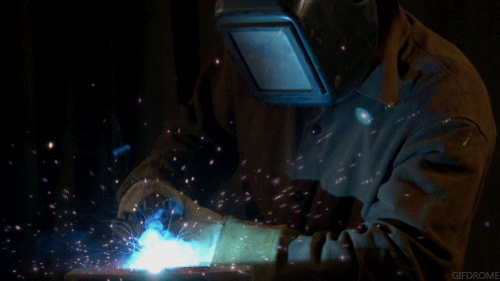I've got some crazy projects in the works ATM so I decided to start . . . whatever this turns out to be?
Some tips will be very basic, some advanced, some garnered from source materials, experts and hard won experience leavened with some crazy creative problem solving over the years. I made a very good living by coming up with outside the box solutions for the problems of millionaires in the Big Apple, 'nuf said.
As many tools, tips-n-tricks as I could lay my grubby little paws upon before going to work later to hide in a series of pics of several projects in the works: IOW, Where is Waldo?




Here are a few in detail:


Safety 101:

Never, Ever, ever hit a hardened steel tool with a hardened steel tool!
Abusing the Framing Hammer. Rip Claw inserted gently to remove end skid from bottom of a pallet by whaling away at it with the Ball Peen Hammer. The striking surface of a hammer is called the bell, it's hardened on basic hammers. Peen Bell is not hardened so it's OK to smack the framer.
The flat side of a hammers is called the cheek, it's not hardened and so that surface is used for whacking things like a punch, cold chisel or the like as above on a job site. Framer in one's tool belt would be whacked with the cheek of the framer from a co-worker's belt.
Hardened to hardened steel strikes can shatter one tool or the other, so just don't do it and use eye protection anyway.
edit: Stuff to whack with one hammer and the cheek of the other. So many hammers for so many purposes, check it out online. Fascinating stuff for tool types and for homeowners, you can likely find a list of what you should be looking out for at garage sales, thrifts and the like.
Sledge hammers down through Engineer's Hammers and the light ones in the two to three three pound range we used to call Lump Hammers are for whacking all kinds of things, some are hardened, some not, some made of wood, bound leather or whatnot (never rubber) be careful, know what you're buying, how you use them and for what. Apparently almost anything can be found using that search term.

TBC
Some tips will be very basic, some advanced, some garnered from source materials, experts and hard won experience leavened with some crazy creative problem solving over the years. I made a very good living by coming up with outside the box solutions for the problems of millionaires in the Big Apple, 'nuf said.
As many tools, tips-n-tricks as I could lay my grubby little paws upon before going to work later to hide in a series of pics of several projects in the works: IOW, Where is Waldo?
Here are a few in detail:
Safety 101:
Never, Ever, ever hit a hardened steel tool with a hardened steel tool!
Abusing the Framing Hammer. Rip Claw inserted gently to remove end skid from bottom of a pallet by whaling away at it with the Ball Peen Hammer. The striking surface of a hammer is called the bell, it's hardened on basic hammers. Peen Bell is not hardened so it's OK to smack the framer.
The flat side of a hammers is called the cheek, it's not hardened and so that surface is used for whacking things like a punch, cold chisel or the like as above on a job site. Framer in one's tool belt would be whacked with the cheek of the framer from a co-worker's belt.
Hardened to hardened steel strikes can shatter one tool or the other, so just don't do it and use eye protection anyway.
edit: Stuff to whack with one hammer and the cheek of the other. So many hammers for so many purposes, check it out online. Fascinating stuff for tool types and for homeowners, you can likely find a list of what you should be looking out for at garage sales, thrifts and the like.
Sledge hammers down through Engineer's Hammers and the light ones in the two to three three pound range we used to call Lump Hammers are for whacking all kinds of things, some are hardened, some not, some made of wood, bound leather or whatnot (never rubber) be careful, know what you're buying, how you use them and for what. Apparently almost anything can be found using that search term.
TBC
Last edited:


